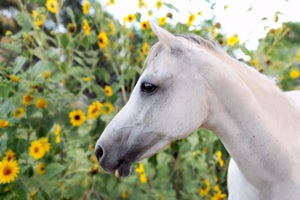Baby steps for horse in need

 Getting Gracie healthy hasn’t been easy. The striking Arabian mare came to the Sanctuary from a severe neglect situation. A horse in need, she was starving, scared and needed a lot of help to look and feel her best again.
Getting Gracie healthy hasn’t been easy. The striking Arabian mare came to the Sanctuary from a severe neglect situation. A horse in need, she was starving, scared and needed a lot of help to look and feel her best again.
Gracie’s physical needs (mainly proper feeding and good hoof care) weren’t difficult to treat. But because her problems weren’t just skin deep, she was about to get some intensive therapy.
Physically, Gracie’s had a great recovery. At 15, she looks healthy, strong and majestic. She’s also smart and has a good enough connection with people, and enough training, to understand what they are asking from her. Gracie does what she needs to do, whether it is getting into a trailer or going on a trail ride. That, however, is a little bit different from willingly participating in these activities.
Horse test anxiety
When it came to riding or getting into a trailer, Horse Haven trainer Ann Hepworth explains, Gracie had the equivalent of test anxiety. She reacted the way people with test anxiety do, associating schools or classrooms with their anxiety, in addition to the tests themselves. She really wanted nothing to do with them and would avoid them if she had the choice.
An example of this might be a person who is afraid of heights being persuaded by a friend to go bungee jumping. The person might be physically able to perform the act of gearing up and jumping off a platform, as well as understand the mechanics of it. But the person might be frantic, wishing that both feet were firmly planted on the ground throughout the whole thing.
Stepping back to go forward
Gracie is such a good horse that she would always do what people asked of her, but it didn’t make her feel very good on the inside. Horse Haven trainers knew they had to take a step back in order to help her overcome this obstacle. That was really the only way she could become a completely healthy and happy horse.
One of the things that helps Gracie the most is when, in certain situations, her caregivers and trainers go as slowly as she needs them to go. So instead of her trainer deciding to load her up in the trailer and take her for a trail ride, there are baby steps. If Gracie is OK with climbing in and out of the trailer and going to the trailhead, but she’s only comfortable with walking 100 yards or so, that’s as far as they’ll go.
Adopt a horse from Best Friends
In sync horse
 “It’s not like moving cattle from point A to point B,” says Jen Reid, Horse Haven manager, explaining that she and the other trainers don’t have a particular end goal when working with Gracie in this way. The point is to help Gracie gain confidence in what she is doing, and not just do things to make people happy. The best part is that, as she gains that confidence, Gracie pushes forward on her own.
“It’s not like moving cattle from point A to point B,” says Jen Reid, Horse Haven manager, explaining that she and the other trainers don’t have a particular end goal when working with Gracie in this way. The point is to help Gracie gain confidence in what she is doing, and not just do things to make people happy. The best part is that, as she gains that confidence, Gracie pushes forward on her own.
Now when she’s on the trail, Gracie actually notices her surroundings instead of just cruising on autopilot. That’s a good sign, even if some things still scare her. It means she’s in tune with the physical world around her, that she’s actively engaged and thinking, and that her overall stress level is lower. And it’s how Gracie has gone from being a scared horse who was just trying to survive to one who’s beginning to enjoy life to the fullest.
Note: All efforts to get Gracie healthy and happy recently paid off in a big way. She was just adopted.
Photos by Ann Hepworth and Molly Wald